15 of the Most Venomous Creatures to Roam the Earth
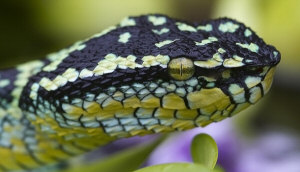 There are plenty of creatures throughout the entire world that we would
rather not be locked in a room alone with. These animals can be deadly for a
variety of reasons. One of the scariest and deadliest of these reasons is the
fact that they could be poisonous. There are a wide variety of different types
of animals that carry varying degrees of poison within them. From insects to
beasts to sea animals, they are scattered throughout the world. Not only can
they be scary to look at, they can have some insanely strong venom at their
disposal. It's important to know about all of these creatures, where they exist,
and what they look like. Just in case you find yourself staring at one of these
deadly creatures. There are plenty of creatures throughout the entire world that we would
rather not be locked in a room alone with. These animals can be deadly for a
variety of reasons. One of the scariest and deadliest of these reasons is the
fact that they could be poisonous. There are a wide variety of different types
of animals that carry varying degrees of poison within them. From insects to
beasts to sea animals, they are scattered throughout the world. Not only can
they be scary to look at, they can have some insanely strong venom at their
disposal. It's important to know about all of these creatures, where they exist,
and what they look like. Just in case you find yourself staring at one of these
deadly creatures.
15) Blue Ringed Octopus
Known as the most venomous creature roaming the sea,
the blue ringed octopus is a force to be reckoned with. They are a group of
around three or four species that tend to dwell in tide pools and coral reefs of
the pacific and Indian ocean. The creature itself is quite small, averaging a
length of around 20cm. What it lacks in size, it more than makes up for its
ruthless behaviors and powerful venom. The blue ringed octopus contains a
neurotoxin that is 10,000 times stronger than cyanide. This poison is injected
through its beak, and paralyzes the entire body. This poison is extremely
venomous to humans, and a large male can die within minutes if not medically
treated. The blue ringed octopus can be spotted by its iridescent blue rings on
the skin of the cephalopod.
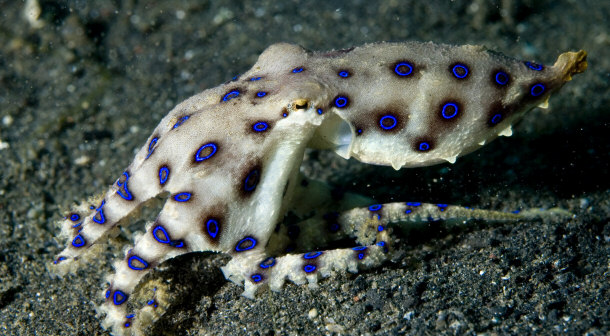
14) Portuguese Man o' War
Also known as the Man-o' War, or bluebottle, this
marine cnidarian is another extremely venomous sea dweller.
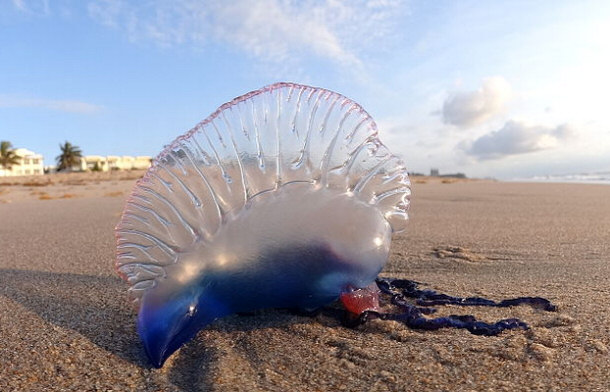
By Volkan Yuksel (Own work) [CC-BY-SA-3.0],
via Wikimedia Commons
Its tentacles can
deliver a powerful sting, stronger than many jellyfish. What many people don't
realize is that it's actually not a jellyfish but a siphonophore, which is a
colonial organism made up of many minute creatures called zooids. This unique
biological feature means that each zooid is attached to one another and
physiologically connected as well. If they were to separate, they would be
incapable of survival. The Man-o' War dwells near the surface of oceans around
the world. It has no means of moving on its own, so it relies on a combination
of currents and tides.
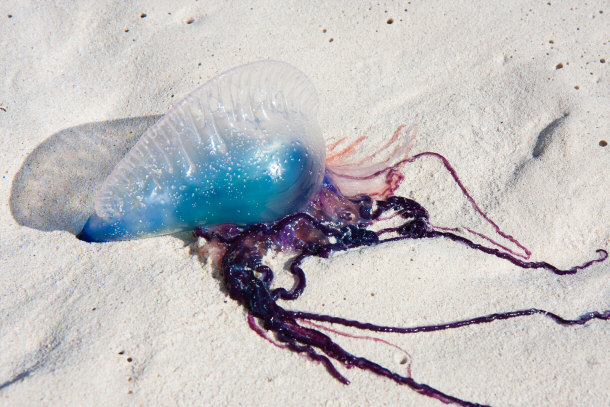
13) Deathstalker Scorpion
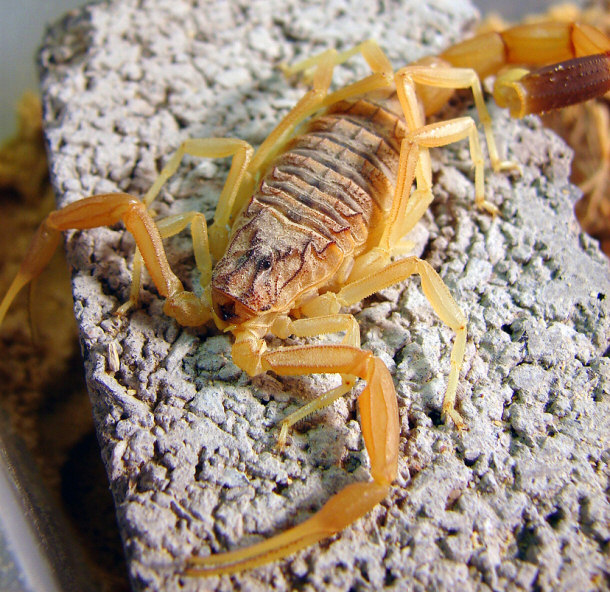
The Deathstalker scorpion is another one of those animals that scare the
living daylights out of us. These little devils range anywhere from 30-77
millimeters and typically reside throughout North Africa
and the Middle East. These are the most venomous creatures roaming throughout
those countries. The Deathstalker scorpion is extremely dangerous because of a
powerful neurotoxin it injects via stinging. It's an extremely painful sting,
although not fatal to the average adult human. Young children or the elderly are
the most susceptible to this poison. An unfortunate result of being stung by
these scorpions in the United States and other countries outside of North Africa
and the Middle East is that most anti-venom has not been approved by the FDA. Be
very careful when traversing the countries listed or else you're going to be in
a world of extraordinary pain later on.
One fascinating thing about these scorpions is they have the ability to glow in the dark and confuse their
predators:
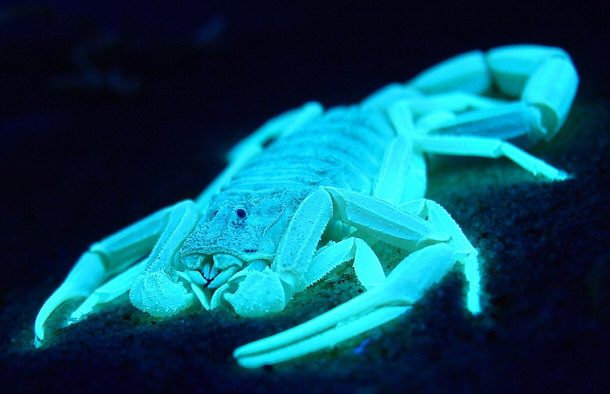
12) Cone Snail
Brace yourselves for this one, ladies and gentlemen. This snail
is not the quickest of venomous animals but extremely dangerous. The geographic
cone snail is a carnivorous invertebrate that measures 4 to 6 inches. Also known
as the cigarette snail, due to the common saying that one has enough time to
smoke one cigarette before they perish to its deadly toxin.
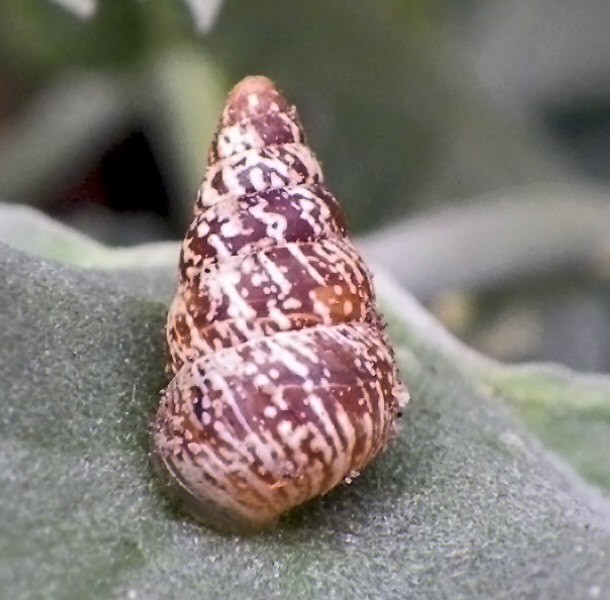
The toxin secreted
by the geographic cone snail is enough to paralyze instantly. The venom is a
complex variety of hundreds of combined toxins, delivered through a proboscis.
Victims need to surface immediately or risk dying from suffocation in the water.
An interesting fact about these snails is that some of the compounds contain
proteins, which are potentially huge pain-killing substances. Researchers have
shown that the proteins are up to 10,000 times more potent than morphine, and
not containing morphine's addictive properties too. Geographic cone snails are
none-the-less one of the most venomous creatures on the planet. In the future,
hopefully scientists will find a way to harness the potential of these snails as
a better pain killing remedy than some of the other drugs currently in the
market.
11) Atracinae
Also known more commonly as the Australian funnel-web spider,
the Atracinae is in a sub family of spiders who make funnel webs. While some of
these spiders have significantly important medical venom, the Atrax robustus
subspecies has one of the most potent venoms on the planet.
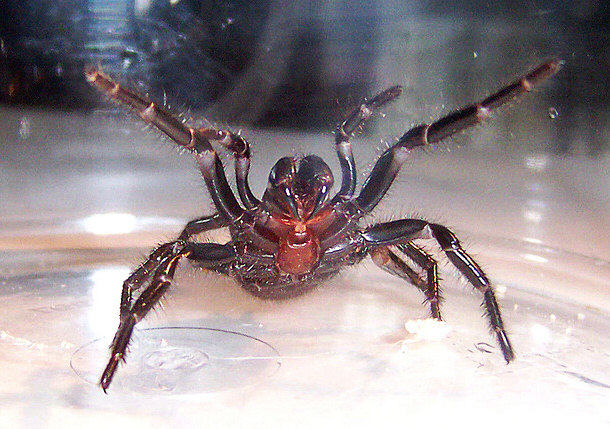
This Australian
critter can range from 1.5 to 5 cm in length. They are nasty looking
creatures, darkly colored and ranging from blue-black to brown, with a hairless
carapace covering their body. Medical researchers have records of bites that
indicate the male version of these spiders is extremely hostile. Pair that with
having some of the most deadly toxins dripping from their fangs, these spiders
are not to be messed with. If a funnel-web spider finds itself to be in a
dangerous situation, it will defend itself to the death. There are many
different varieties of toxins that Australian funnel-web spiders possess, and
they are all categorized under atracotoxins. Extremely deadly to primates, the
venom is actually harmless to other types of animals. A female's bite does not
come even close to being as deadly as the males bite. Symptoms can range from
sweating, tingling sensations, twitching, and elevated heart rate, to more
severe symptoms such as muscle spasms, metabolic acidosis, and extreme
hypertension.
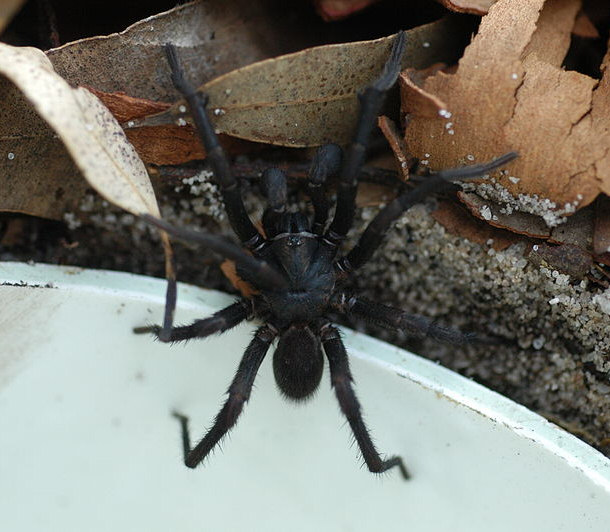
By Doug Beckers from Macmasters Beach, Australia [CC-BY-SA-2.0],
via Wikimedia Commons
10) Brazilian Wandering Spider
Humans are naturally afraid of spiders. It's
been genetically engrained into our DNA that we are to avoid spiders at all
costs. The Brazilian Wandering Spider is the most likely reason that this
occurrence has happened.
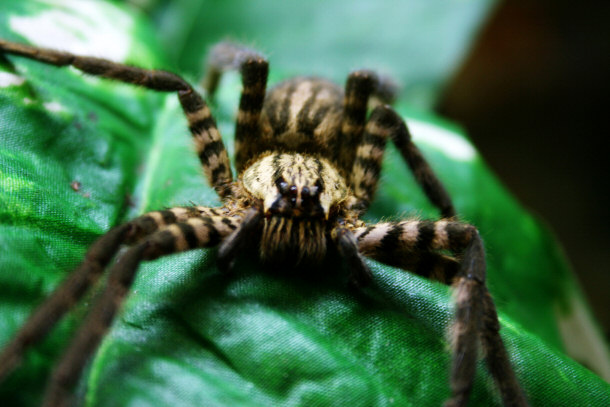
This arachnid contains the most deadly venom out of all
other spiders in the world. This wandering spider is not the largest of
arachnids, and can have a leg span of only four to five inches. It makes up for its size by being extremely aggressive and with
its potent venom as well. What this dangerous predator does is run around on its
eight legs at night looking for potential victims. It can be identified
immediately by the red hair that covers its fangs. It also has a tendency to
rear up on its hind legs at the slightest notion of danger. The Brazilian
Wandering Spider is not afraid of humans and will attack immediately if
provoked. A strange fact about these spiders is that they do not always inject
poison when biting their victims. Only 30% of their bites contain venom. Another
reason to stay as far away from these critters is that they are cited by the
Guinness Book of World Records as the most dangerous spider ever. Their bites
alone have contributed to more human deaths than any other spider in the world.
Warning: Do not try this yourself!
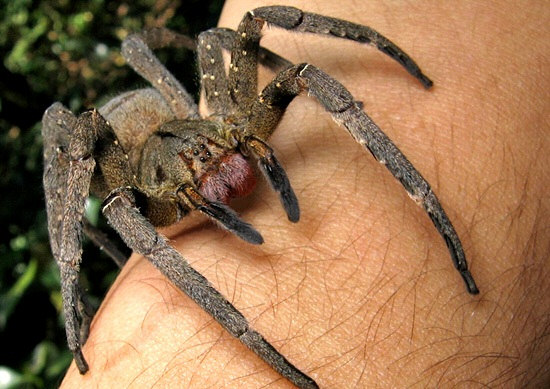
By Joćo P. Burini (Own work) [GFDL or CC-BY-SA-3.0],
via Wikimedia Commons
9) The Beaded Lizard
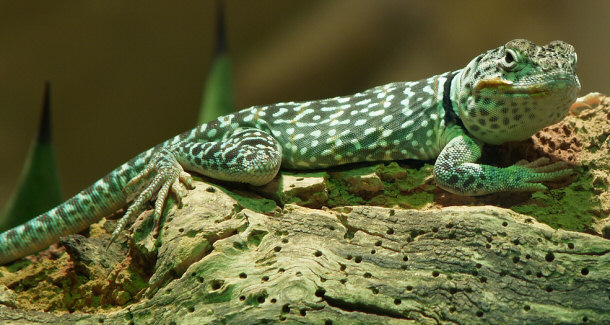
The beaded lizard is an extremely venomous reptile that
is luckily an endangered species as well. It's a predator that feasts typically
on eggs in its local habitat. Adult beaded lizards usually range anywhere from
750 to 900 millimeters in length, depending on gender. Commonly associated with its congener, the Gila monster, a beaded
lizard is much larger and just as vicious. Typically black with various yellow
spots throughout the body, the beaded lizard has small scales with small
beadlike protrusions coming out of each of the scales. What makes these lizards
so dangerous is located in its venom glands, which are located within its
salivary glands. When a beaded lizard bites its victims, it doesn't let go. Its
powerful grip is used to make sure most of its venom enters the wound the lizard
has created. While not instantly fatal, the venom has been known to cause
respiratory failure in humans. More serious effects of the venom mammals are
hypothermia, edema, and internal hemorrhaging. This lizard is on the CITES
endangered species list, and only 200 still exist within the wild. You won't
have to worry about this lizard during the day time, as they primarily come out
only for one hour at night.
8) Rattlesnake
We are about to present one of the most dangerous and venomous
animals roaming the planet, the rattlesnake.
Southern Pacific Rattlesnake (Crotalus viridis helleri) coiled and ready to strike:
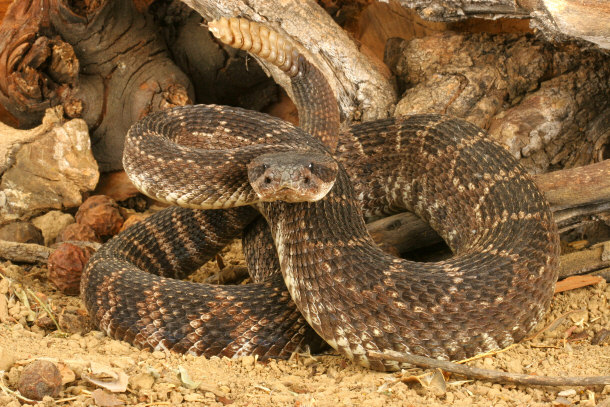
Western Diamondback Rattlesnake (Crotalus Atrox):
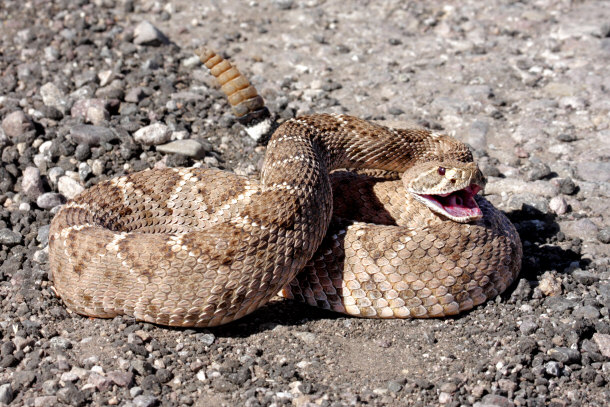
This insanely dangerous predator is
brown-black with various hues of yellow, and can be spotted or heard immediately
because of the rattle at the end of its tail. Being a part of the pit viper
family, they can strike at distances up to 2/3 of their body length, meaning
they can go very far. The most dangerous in the rattlesnake family is known as
the Eastern Diamondback rattler, and this is because they have the most recorded
human deaths associated with their bite.
Eastern Diamondback rattler:
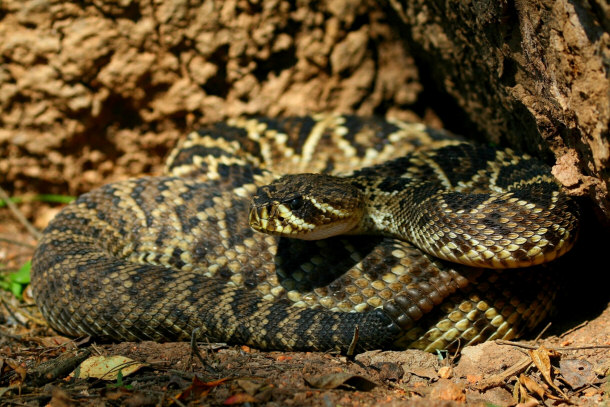
An interesting fact about the
rattlesnake family is that the young, newly born snakes are more venomous than
their older relatives. This is due to the fact that they cannot control the
amount of venom they inject into their prey. The rattlesnake's venom is known as
a hemotoxic. The venom has the potential to destroy tissue, degenerate organs,
and can disrupt the blood clotting process. If not treated immediately, the
venom can lead up to the loss of a limb, and permanent scarring will occur. If
not treated at all, most cases of human bites untreated resulted in death. If
rattlesnake antivenom is nearby, the rate of fatality goes down to around 4%.
These continue to be the largest and most venomous snakes roaming North America,
according to National Geographic.
7) The Fierce Snake
Here comes another extremely venomous snake on the list.
The Inland Taipan, better known as the fierce snake, is considered the most
venomous snake on the planet, according to the Australian Museum. The reason you
don't hear much about this deadly snake is because it's docile and only resides
in certain parts of Australia. Just to give you an idea of how deadly this snake
is the yield of venom that has been injected is .03mg/kg. In laymen's terms,
this is enough venom to kill 100 humans, or 250,000 mice at one time. Inland
Taipan snakes are brown in color and tend to remain as far as possible from
humans.
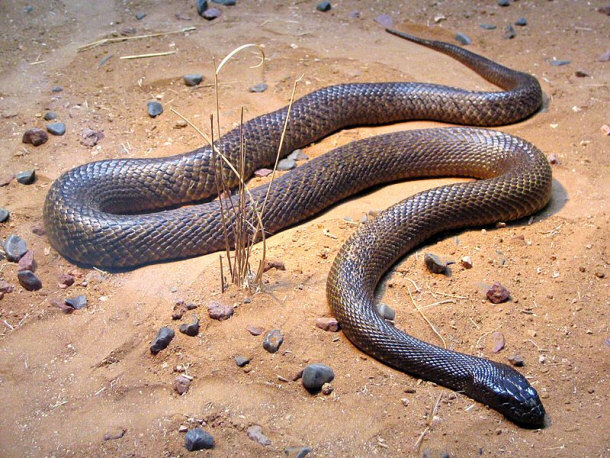
XLerate at the English language Wikipedia [GFDL or CC-BY-SA-3.0],
via Wikimedia Commons
6) Stone Fish
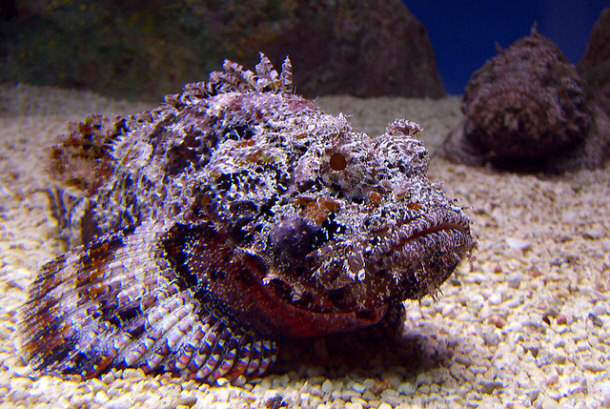
You can barely see it's mouth and eyes:
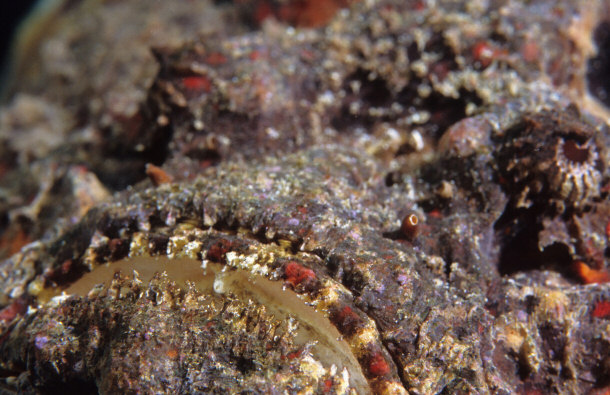
The stone fish, also known as Synanceia, is an extremely
venomous fish. So venomous, their toxins can prove fatal to human contact. This
rather strange looking fish is the most toxic fish known to man. The stone fish
got its name due to the appearance to looking like a stone at the bottom of the
ocean. It normally dwells in the coastal region of the Pacific and Indian oceans
and has been spotted in the Caribbean as well. The stone fish has powerful
neurotoxins secreted from the glands located within their spines. A typical
warning sign from the stone fish is when their dorsal fins begin to stretch
upwards, signifying an imminent attack. The sting of a stone fish can cause
severe pain and death if not treated immediately. One unique factor that results
in unknowing humans picking up the fish is the ability for stone fish to leave
the water for up to 24 hours. They are then discovered by humans and not known
how to be dealt with. Keep your distance from a fish with fins that appears to
be a rock, and you'll escape the fate of being stung by a Synanceia.
5) Belcher's Sea Snake
If we're going to talk about the most venomous
creatures on Earth, the Belcher's sea snake is definitely one of the most
venomous. Also known as the faint-banded sea snake, the main reason you don't
hear many cases about this animal attacking humans is because of its mild
temperament.
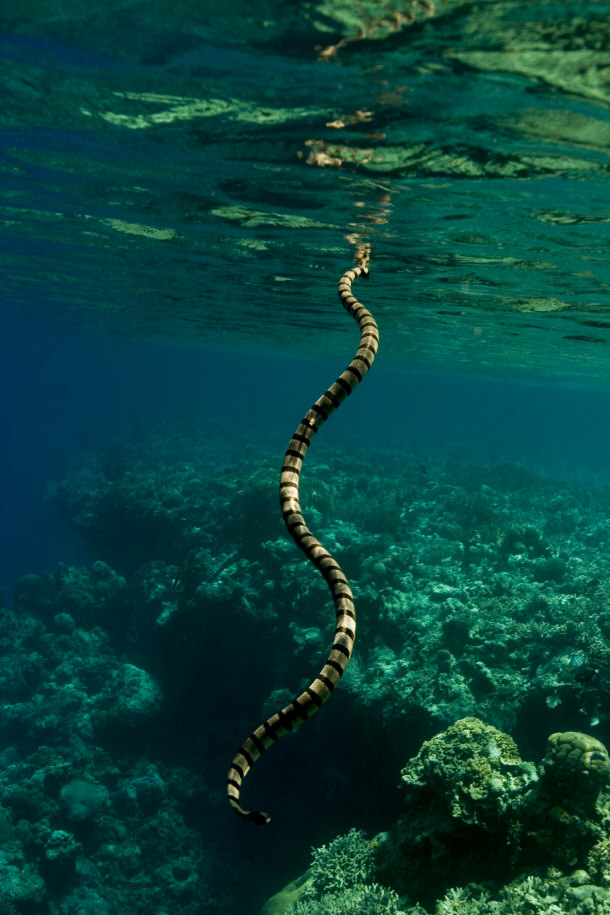
Many divers and fishermen have stated that it will only bite if
mishandled or threatened. The venom within this beast of the sea is potent
enough to kill 1,000 human beings with one bite. The sea snake ranges from 0.5
to 1 meter in length. The body appears iridescent, with yellows and greens in
rings throughout its body. Belcher's sea snakes are expert swimmers, and hunt
fish and shellfish. It breathes air but can remain submerged underwater for up
to eight hours before surfacing. Scientists have stated these snakes have the
possibility to reside in any warm water area, but they are primarily located in
the Indian Ocean. They can also be located in abundance in the Ashmore Reef off
the coast of northwest Australia.
4) Box Jellyfish
The Box Jellyfish is, according to the Guinness Book of
World Records, the most poisonous animal in the world. This type of jellyfish is
known throughout the world as an animal to be avoided at all costs. Stings from
the Carukia barnesi, Malo kingi, and chironex fleckeri, are extremely painful
and sometimes fatal to humans. The box jellyfish look different than other fish
and have an umbrella shaped appearance. The underside of the box jellyfish
contains an extremely advanced nervous system. There is a certain nerve ring
located at the beginning of their umbrella-shaped body that allows them to
coordinate their movement better than other jellyfish. This, paired with the
shape of the jellyfish, help it propel its body at speeds upwards of six meters
per minute. This doesn't seem very fast but imagine a school of hundreds of
jellyfish approaching you while in the middle of an ocean. The areas that box
jellyfish typically reside are in the Indo-Pacific regions, as well as all
subtropical oceans.
A School of Box Jelly Fish Swimming Around:
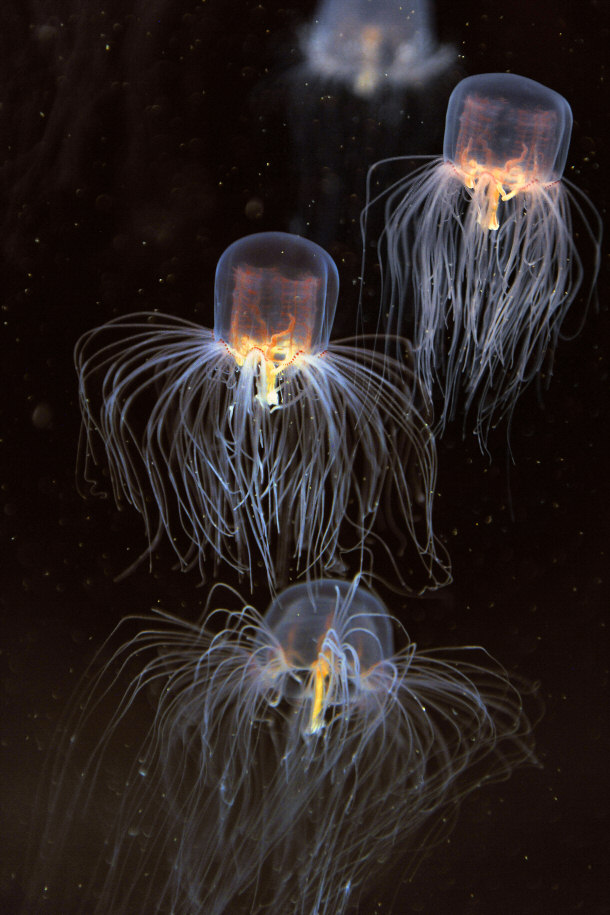
The tentacles of a box jellyfish contain hundreds of thousands of cnidocytes,
which are receptacles for nematocysts. These nematocysts are microscopic
organisms that injects venom into potential dangers. An unfortunate problem that
occurs with most jellyfish stings is the fact that it is not felt until the
venom is actually injected into the body. Australian waters are the most common
area for these box jellyfish to reside, and it also happens to be the area where
the most people are stung. A helpful tip when diving and near an area with box
jellyfish is to wear panty hose. The panty hose protects you from the
nematocysts that jellyfish produce.
3) Puffer Fish
One of the more commonly known of the most poisonous animals
in the world is the blowfish, otherwise known as the puffer fish.
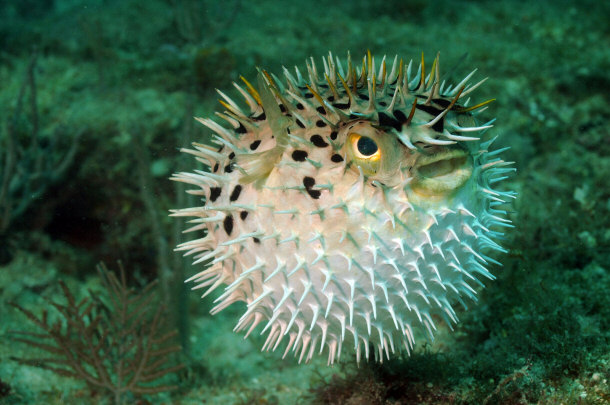
This seemingly
cute, sea dwelling critter is quite dangerous, being the 2nd most venomous of
vertebrates in the world. Also known as blow fish, there are over 120 species of
puffer fish around the world. Most of these fish live in estuarine waters;
however 29 different types of puffer fish live predominantly in freshwater. What
makes the puffer fish so deadly is its natural defense mechanisms. Situated
throughout the body of the puffer fish, in the pectoral, anal, dorsal and caudal
areas are fins. These fins allow the puffer fish to pivot almost
instantaneously, although it isn't able to propel itself at a fast speed. The
final line of defense for the puffer fish would have to be its poison, tetrodotoxin. This type of toxic poison makes a puffer fish extremely foul
tasting and unpleasant. The toxin exists throughout the entire body of the
puffer fish, and it has been known to kill humans.
Fortunately, not all puffer fish are deadly. Some puffer fish have no poison
within them at all, and there is varying degrees of toxin in the 120 different
types of puffer fish. One unique fact about puffer fish is that despite their
extremely dangerous neurotoxin, many consider it a delicacy. In Japan, as well
as sushi restaurants around the world, puffer fish is served up in a delicate
way. Specific slices of the fish contain no neurotoxin at all, and you're
leaving your life in the hands of a sushi chef's level of expertise. Raw puffer
meat can cause intoxication, light-headedness, and numbness, while cooked puffer
meat can cause death. Prepare yourself before deciding to try this delicacy, and
be sure you go to an established restaurant.
2) Poison Dart Frog
The dart frog, also known as the poison arrow frog, is another one of the
world's most deadliest creatures. These frogs are found
throughout central and South America. They can be distinguished by the various,
brightly colored bodies that they can possibly have because of being diurnal in
nature. The reason they are called dart frogs is because of the indigenous
tribes within South America that use the poison of these frogs for their
weaponry. Poison dart frogs are one of the tiniest animals on this list, less
than 1.5 cm in length. Being so small has been the reasoning as to why it has
developed so many natural defense mechanisms over millions of years. These frogs
are aposematic organisms, meaning that they have brightly colored bodies in
order to warn potential predators that they do not taste good. They have also developed an advance method of delivering
toxins through their skin. Poison dart frogs secret lipophilic alkaloid toxins
through various glands throughout their body. There is an interesting theory
behind how poison dart frogs actually create their toxins. Certain scientists
believe that these frogs have the ability to sequester the chemicals needed to
make their toxin from other pretty items, like insects. Certain animals over
time and within the frog's habitat have developed immunity to the poison,
including many snakes.
These Poison Dart Frogs Represent Uniquely Gorgeous Colors:
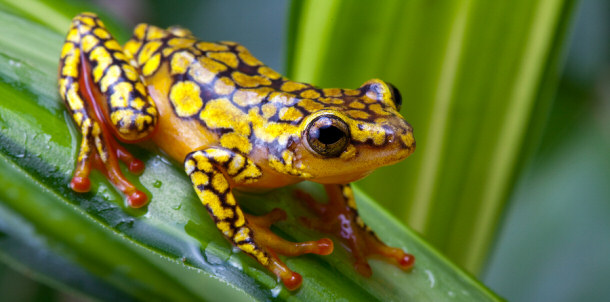
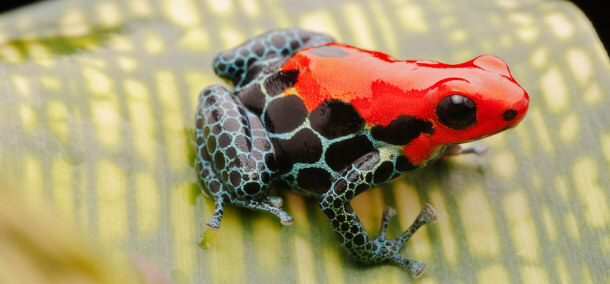
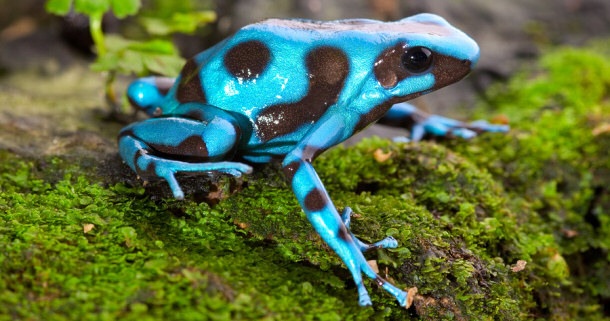
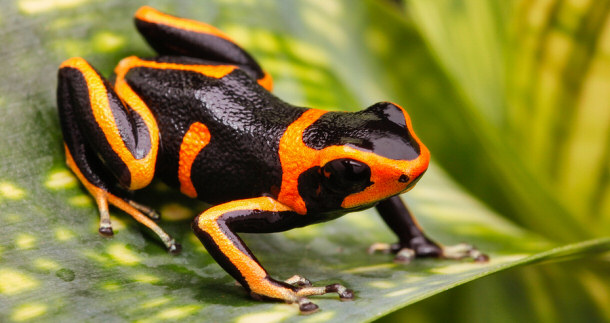
1) Black Mamba Snake
Closing up the list, but definitely not the least
venomous of the animals we mentioned, is the Black Mamba snake. This is
currently the longest venomous snake known in Africa, coming in at around an
average of 3.2 meters. Record sizes have indicated that these black mambas can
grow up to 5 meters long. The reasoning behind the name black mamba is due to
the black color of the interior of the snake's mouth, which it shows to
potential victims when it feels threatened. The actual body color of the snake
appears to be metal gray. One unique and scary fact about the black mamba snake
is that it is the fastest snake in the world. At top speeds, this snake can move
at a rate of 20 kilometers per hour (12 MPH). The snake is also extremely aggressive in
nature, not afraid of humans and more than likely willing to engage humans.
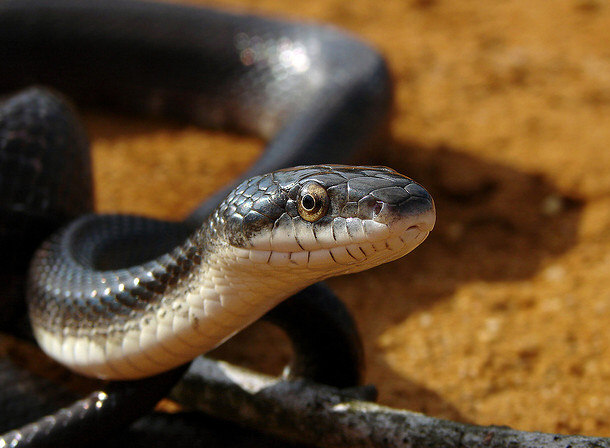
The venom of the black mamba snake is also known to be some of the fastest
acting venom of all snakes. It's a combination of potent neurotoxins and
dendrotoxins. The venom is low in molecular weight, which means it can spread
rapidly through the tissue of its prey. According to researchers, 10-15
milligrams of poison are needed to kill an average size human being, and the
bite of a black mamba carries 50-120 milligrams. The venom is known for
constricting respiratory systems extremely fast, eventually leading to cardiac
arrest. The fastest known death due to envenomation from the black mamba is 10
minutes. The easiest way to protect yourself against the black mamba snake is to
spot it before it spots you and gain as much distance as possible. The
aggressive nature of this snake means that it will not stop following prey for a
very long distance, and people most at risk are children and the elderly.
Conclusion
Venomous creatures exist all over the world and we have been living with them
for thousands of years. Throughout the past 400 years, humans have been
documenting and finding ways to protect ourselves from these creatures. What is
still being researched about on a daily basis is the various ways we can use the
venom of all these animals to create medicine that can potentially save human
lives. Many of the venomous creatures within the world have a wealth of
knowledge yet to be tapped within their venom. Proteins are being discovered
that not only reduce the side effects of the actual toxin itself, but can
provide pain-killing relief 10 times stronger than morphine, one of the
strongest forms of pain-killers present in the modern world. Also, new chemicals
that are used for the treatment of major diseases have been found in the toxins
of spiders and snakes all over the world. Over time, scientists will be able to
understand the nature venom within the world, and tap the antivenins and
preventative cures that these toxins can possess.
Taking time to understand the variety of venomous creatures in the world
creates a better understanding of the world around us. Not only does this
information provide knowledge of Mother Nature in general, there may even be
certain instances that you're faced with one of these deadly animals. Knowing
the color of a black mamba and the tendencies of a Belcher's sea snake can mean
the difference between life and death. Being aware of the various box jellyfish
that inhabit the coasts of Australia can allow scuba divers knowledge with what
kind of women's clothing they need to wear in order to best protect them. Most
of these animals are easily avoidable in nature, and are not seen on a daily
basis. It's important to understand the nature of all of the venomous animals in
the world, especially if you live in a location near the habitat of said
animals. A few preventative measures and safety precautions learned can save
your life or the life of someone else.
Nature
Top Lists:
15 Fascinating Facts about the Amazon Rainforest
15 Remarkable Facts About Bacteria
15 Remarkable Facts About Jellyfish
15 Little Known Facts About Elephants
15 Fascinating Facts about Earthquakes
15 Odd And Interesting Facts about Monkeys
Top 15 Myths about Snakes
Top 15 Myths about Horses
Top 15 Creepy Deep Sea Creatures
15 Unexpected Animals That Can Kill You Quickly
Top 15 Spider Myths
15 Beautiful Animals that are Now Extinct
Top 15 Most Amazing Snakes Around the World
15 Fascinating Facts about Snow
Top 15 of the World's Rarest Flowers
10 Most Emotional Animals
15 of the Most Venomous Creatures to Roam the Earth
15 Unusual Animal Defense Mechanisms
15 Unusual and Less Known Uses of Rocks
15 Unique Forest Creatures Less Known To Man
15 Interesting Facts About Time
15 Unknown Parasites You Never Knew Existed
15 Weird Trees Around The World
15 Wild Animals Deadly to Humans
15 Exotic Insects That Are Harmful & Deadly
15 Ridiculous Uses for Gold
Informational:
Preparing for a Disaster
Proof That We Are What We Are!
What is the Meaning of Life?
The Trend and Challenges Facing the Urban World
Creation Narratives and the Evolution Creationist Debate |